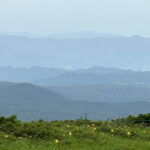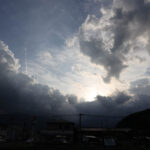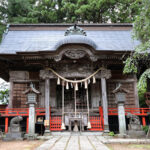Long ago Oman no Kata, a princess who was the daughter of the Kyoto Lord Sanjo Morimitsu, travelled to Oshu (present day Fukushima, Miyagi, Iwate, Aomori and parts of Iwate Prefectures) in a dream, and subsequently went there and became the wife of a charcoal burner called Tota in the mountains of Togatta. While he was burning charcoal, he discovered the Iwasaki-yama gold mine (today’s Kagoyama) and prospered. The couple had three children, the eldest of whom, Kitsuji, took over the family business and sold the gold he had discovered. This was Kaneuri Kitsuji, the gold seller. Kitsuji discovered a sacred spring while excavating the Iwasaki gold mine.
The hot spring was opened in 1601 by Kaneuri Kitsuji and Togatta Onsen developed as an inn town and therapeutic bath town for worshippers who went up to Zao Gongen, now the Kattamine Shrine on top of the Katsuta-dake Mountain.
While some say that the excavation of the Iwasaki gold mine began in the Keicho era (1596 -1615); and the discovery of the hot spring occurred in the early Tokugawa era (1603 -1867), according to the History of Katta-gun (county), ‘This hot spring was first discovered by a fourth-generation grandson of the Onuma family, named Kanjuro, who served Kamo Ujisato, settled here, cultivated the wasteland and discovered the hot spring in September of Keicho 6. Afterwards, another hot spring was discovered in March, 5th year of the Genbun era . . . ’ (1736-1741).
There is also a legend that says that an eel living in Fudo-daki Waterfall in the upper reaches of the Matsu-gawa River fought a duel with a large crab from Sankai-daki Waterfall. The eel was defeated, and its tail washed ashore at the hot spring. Since the tail of the giant eel drifted down, the hot spring is thought to have been good for the legs and the feet. Other versions of this legend say that it was a rabbit who lost the duel, and its tail drifted down to the hot spring.
Unlike nearby Aone and Kamasaki Onsens, Togatta Onsen seems to not have entertained clan leaders during the Edo era; but since the Zao eruption in Meiji era, perhaps out of fear, many people visited shrines on Kumano-dake and Katta-ke Mountains, and faith-climbing or mountain worship became popular. According to a booklet Togatta Miyage (Togatta Souvenir), published in Meiji 35 (1902), people took baths after visiting the Kattamine Shrine, resulting in 1000 to 3000 bathers per day, and no less than ten thousand a year. At the time there were eighteen ryokans and four hot springs in the town.
In recent years archaeologists digging in the valley of the Matsu-kawa River, and especially on the eastern and western foothills of Aoso-san, have found evidence of previous occupation of the area by Jomon people. Their weapons, tools and pottery have been dug up; some dogu figurines have also been found. It is very likely that the volcanic activity in the area, and especially the hot springs, were attractive to prehistoric peoples as well.
Drawing of Togatta Onsen from Togatta Miyage (Togatta Souvenir), published in Meiji 35 (1902)
Cover of Togatta Miyage (Togatta Souvenir), published in Meiji 35 (1902)
Dogu found in Kajisawa Iseki on the foothills of Aoso-san. Photo courtesy of Zao Kyoiku Iinkai (Education Committee).








Recent Comments